Summary
Background and Aims
Chronic hepatitis C virus infection is prevalent among 200,000 individuals in Poland; however, few are aware of their condition (30,000 diagnosed) and even fewer are treated (2490 in 2014). This analysis projected future disease burden and developed two treatment scenarios to control or eliminate hepatitis C virus-related disease in Poland.
Methods
Using a modeling approach, the infected population and future disease progression were quantified. Baseline variables included viremic prevalence, age and sex, diagnosis rate, treatment rate, disease progression, and sustained virologic response rates. Data were collected from the literature and through expert interviews.
Results
The number of prevalent hepatitis C virus infections is projected to decrease (5%) by 2030. However, the numbers of individuals with compensated and decompensated cirrhosis, and hepatocellular carcinoma are estimated to increase by 40, 55, and 60%, respectively. By increasing sustained virologic response rates to 95% from 2015 onward, and the number of treated cases (from 2490 to 5000), the number of individuals with cirrhosis, decompensated cirrhosis, and hepatocellular carcinoma is projected to remain constant until 2030. A strategy to eliminate chronic hepatitis C virus infection was also considered. To reduce total infections by 90% and mortality by 80%, treatment was increased to 15,000 patients annually. This scenario required the diagnosis of 15,000 new cases (compared with 3000 today).
Conclusion
A marked reduction in hepatitis C virus-related disease burden is possible, with increased diagnosis and treatment. The results could inform the development of effective disease management in Poland.
Countries: Poland

